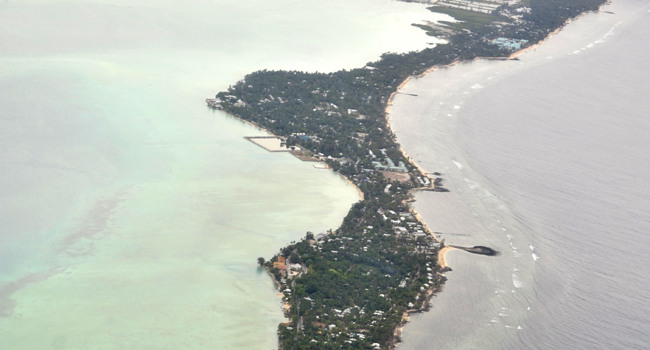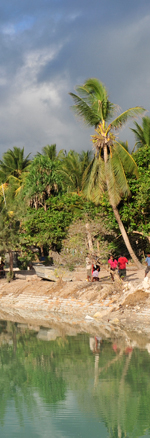
Kiribati is located in the central Pacific region and is comprised of 33 atolls with approximately 800 km2 of land area. The maximum height found on any of the atolls is 4 m, which makes the country vulnerable to sea level increases, saltwater intrusion and floods. The vulnerability and adaptation studies carried out in the country showed that the largest impact of climate change would be loss of coastal infrastructures due to inundation. Moreover, bleaching of coral reefs would result in loss of fish production. The combined effects of coastal erosion due to sea level rise, precipitation changes and higher temperatures would result in considerable reduction of the thickness of water lenses. Climate change would be likely to increase the epidemic potential of dengue fever and the incidence of tropical diseases. Sea level rise would also affect agriculture due to saltwater intrusion and loss of coastal land, thereby reducing land available for agriculture.

Timelines of the NAPA preparation process in Kiribati
| Funding for the preparation of the NAPA approved by the GEF |
October 2003 |
| GEF agency approval date |
October 2005 |
| NAPA preparation start |
June 2004 |
| Submission of the NAPA to the UNFCCC |
January 2007 |
NAPA projects under implementation
Kiribati's NAPA outlined 10 priority activities. The first project submitted to the LDCF is aimed at strengthening the resilience of Kiribati to the impact of climate variability, climate change and climate-related hazards by reducing the impact of storm surges and coastal erosion on the quality and availability of freshwater resources and the livelihoods of coastal communities.
| Project title: Increasing resilience to climate variability and hazards |
| Implementing agency |
World Bank (International Bank for Reconstruction and Development (IBRD)) |
| Number of NAPA priority activities addressed |
5/10 |
| Cost in USD million (LDCF component/total cost) |
3.300/6.600 |
| First submission of the concept note (PIF) under the LDCF |
August 2009 |
| GEF CEO endorsement of the project |
Not CEO endorsed yet |
| Update on progress |
the project concept note has already been approved by the GEF Council |
NAPA PROCESS
Preparation and implementation strategy: The Climate Change Study Team (CCST) was involved in the preparation of the NAPA. Their mandate included overseeing the implementation of the UNFCCC and providing technical guidance. During the preparation of the NAPA, the team undertook a thorough consultation with the local population of all the inhabited islands. A wide range of stakeholders representing all layers of the population were consulted including: NGOs, the private sector, registered religious groups, an association of elderly men (according to indigenous customs), representatives of women groups, youth representatives and local government representatives. This created a high level of awareness across all stakeholders. The NAPA preparation process was completed with the help of UNDP and an excellent relationship existed between UNDP and the NAPA team. The NAPA team also received support and technical assistance from the LEG when the expert group came to Kiribati for an LEG meeting. In addition, the team sent their draft NAPA to the LEG, which provided comments prior to finalization of the document.
 |
Due to its increasing vulnerability to climate change, a vulnerability and adaptation (V&A) assessment was undertaken with the help of the GEF prior to the NAPA preparation process. Significant focus during the preparation process was given to matching the results of the V&A and identifying the priority projects. However, the project profiles derived during the prioritization stage of the NAPA stakeholder consultations and the outcomes of the V&A were slightly different. As a result, there is neither a clear implementation strategy nor a clear understanding of the stakeholders role in pursuing support for the projects formulated under the NAPA process.
Shortly before the start of the NAPA preparation process, another adaptation programme was developed under the name Kiribati Adaptation Programme (KAP), which is funded by the GEF and co-financed by AusAID. The KAP is not linked to the NAPA - its objective is to mainstream adaptation into national economic planning and it therefore focuses on long-term planning for adaptation.
Institutional arrangements in the country: Adaptation activities are managed within the framework created by the country''s National Development Strategy. The Kiribati Government has also approved a Climate Change Adaptation Policy and Strategy.
Experience with project implementation: Kiribati's NAPA is implemented concurrently with the Kiribati Adaptation Project (KAP I), which includes pilot projects on a number of islands. A new programme was launched during the fourth replenishment of the GEF Trust Fund.
The World Bank is the agency responsible for assisting Kiribati with the implementation phase of the LDCF project. A PIF was submitted to the GEF, but the document was sent back to the World Bank with a request for further information. The World Bank wanted to merge the NAPA and the KAP projects, but the Government of Kiribati believes that since KAP had already started when the NAPA process began, the projects should not be merged and the NAPA projects should be formulated so as to avoid repetition. The Government of Kiribati also believes that although these two projects have different objectives (KAP addresses long-term planning adaptation and the NAPA addresses immediate and urgent adaptation needs) they must complement one another and be coordinated during their implementation phase. |
Revision and update: Kiribati is interested in revising its NAPA. Although the team does not foresee any major changes over time in the country's selection and ranking of priority adaptation activities, the interest in the revision of Kiribati's NAPA lies in the potential for scaling-up adaptation activities.
| Kiribati's experience shows that multi-stakeholder consultations during the NAPA preparation process can significantly help identify nationwide adaptation needs. |